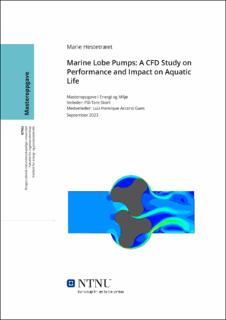| dc.contributor.advisor | Storli, Pål-Tore | |
| dc.contributor.advisor | Gans, Luiz Henrique Accorsi | |
| dc.contributor.author | Hestetræet, Marie | |
| dc.date.accessioned | 2024-01-30T18:19:44Z | |
| dc.date.available | 2024-01-30T18:19:44Z | |
| dc.date.issued | 2023 | |
| dc.identifier | no.ntnu:inspera:149931881:23148807 | |
| dc.identifier.uri | https://hdl.handle.net/11250/3114702 | |
| dc.description.abstract | I denne masteroppgaven ble fluiddynamikken i en tre-lobet pumpe med episykloidale lober undersøkt ved hjelp av numeriske strømningsberegninger. Studien vektlegger vurderingen av pumpens mekaniske interaksjoner med akvatisk liv, spesifikt i marine prosjekter for pumpet vannkraftlagring som ALPEHUS-prosjektet. I tillegg til simuleringene, inneholder oppgaven en litteraturgjennomgang som utforsker relevante temaer som pumpet vannkraftlagring, fortreningsbaserte maskiner og teknikker for numerisk strømningsberegning for slike maskiner.
For de numeriske simuleringene ble en 2D-modell av pumpen lagd og analysert ved bruk av SST $k-\omega$ turbulensmodell. Meshet bestod av en kombinasjon av strukturerte elementer og inflasjonslag, og hadde en maskestørrelse på 1.5 mm. Denne tilnærmingen ble brukt for å balansere beregningshastighet med detaljnivået som kreves for pålitelige resultater. Rotorens bevegelse i fluiddomenet ble simulert ved hjelp av den nedsenkede grensemetoden, der lobene ble behandlet som nedsenkede faste materialer.
De viktigste fluiddynamiske parameterne, inkludert hastighetsprofiler, virvelskapelse, turbulens og trykkfordelinger, ble evaluert for rotasjonshastigheter fra 30 til 500 RPM. Resultatet ga innsikt i pumpens ytelse og antatte påvirkning på det omkringliggende akvatiske livet. Spesielt ser hastigheter opptil 100 RPM ut til å balansere pumpens ytelse med sikkerhet for akvatisk liv. Funnene har som mål å bidra til pågående arbeid med å designe mer effektive, bærekraftige og fiskevennlige PHS-systemer. | |
| dc.description.abstract | In this master's thesis, the fluid dynamics of a three-lobe pump with epicycloidal lobes were investigated using computational fluid dynamics (CFD) simulations. The study emphasizes assessing the pump's mechanical interactions with aquatic life, especially in marine pumped hydro storage (PHS) projects like ALPHEUS. In addition to the simulations, the thesis incorporates a literature review that explores relevant topics such as PHS, positive displacement (PD) machines, and the application of CFD techniques to these types of machinery.
For the numerical simulations, a 2D model of the pump was created and analyzed using the SST $k-\omega$ turbulence model. The mesh employed a structured grid layout combined with inflation layers, settling on a mesh size of 1.5 mm. This approach balanced computational efficiency with the detail required for reliable results. The motion of the pump's rotors within the fluid domain was simulated using the Immersed Boundary Method (IBM), with the lobes being treated as immersed solids.
Key fluid dynamics parameters, including velocity profiles, vortex formation, turbulence, and pressure distributions, were evaluated across a range of rotational speeds from 30 to 500 RPM. The results gave insight into the pump's performance and assumed effect on surrounding aquatic life. Notably, speeds up to 100 RPM seem to strike a balance between pump performance and aquatic life safety. The results offer valuable insights into the pump's mechanical performance and likely impact on aquatic life. The findings aim to contribute to ongoing efforts to design more efficient, sustainable, and fish-friendly PHS systems. | |
| dc.language | eng | |
| dc.publisher | NTNU | |
| dc.title | Marine Lobe Pumps: A CFD Study on Performance and Impact on Aquatic Life | |
| dc.type | Master thesis | |
